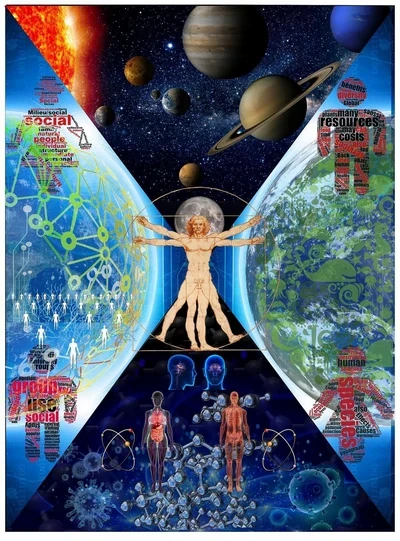Every choice we make occurs in the fleeting moment called "Now." It's in this present instant that we respond to countless pressures from all directions. Many of these choices are not conscious; they are reactions based on patterns we’ve accumulated over a lifetime. But what if, in that single moment, we could make truly conscious choices? It takes as much practice to make intentional choices as we’ve invested in our unconscious responses, shaped by the world around us.
To understand what we face in that "Now," I created a visual representation years ago, illustrating the influences on our choices. This image took the form of an X-shaped quadrant, with "Now" at its centre, and each quadrant reflecting a distinct aspect of the pressures we navigate.
In the top quadrant lies the **macro-universe**, symbolizing our planet’s place in the vastness of the galaxy. Forces in this macro-world, like the gravitational pull of the moon or the cycles of solar activity, impact us directly. While these forces may seem distant, they can subtly influence our emotions and physical well-being, much as the moon affects ocean tides. We feel the interconnectedness of these forces every day, as we respond to their invisible pull without realizing it.
Opposite this, in the bottom quadrant, I represented the **micro-universe**. This space symbolizes everything happening within us: the ceaseless activity of microbes, bacteria, and chemical reactions that keep us alive. We often notice this influence only when something goes awry, perhaps when we feel ill or exceptionally energetic. The balance or imbalance within us is ever-changing, driven by forces within our bodies that we cannot directly control in each moment, yet profoundly affecting our choices and responses.
The **right quadrant** brings us closer to home, symbolizing the **physical environment** we inhabit. Whether it's a lush forest, a bustling urban centre, a mountain, or a shoreline, our surroundings shape how we feel and respond. This influence becomes particularly pronounced when drastic changes like natural disasters, war, or famine disrupt our surroundings. Climate change, too, has brought these disruptions closer to us all, reminding us of the interconnectedness of our environment and its impact on us.
Finally, the **left quadrant** represents **societal pressures**. These pressures stem from our roles within family, work, and community, influenced by norms, traditions, and histories that shape every society. Each of us is affected by the expectations and boundaries of the society we live in, whether we’re aware of it or not. Our position within our families, workplaces, and larger communities all create pressures that shape our decisions and responses in the "Now."
Together, these four influences—the macro-universe, micro-universe, physical environment, and societal norms—combine at every moment. We are often unaware of even a fraction of these influences pressing upon us. So how do we make conscious decisions amid this bombardment?
This is where the practice of self-awareness comes into play. Conscious choice begins with knowing oneself. Socrates famously said, "Know thyself," and this wisdom remains as relevant today as it was centuries ago. If we truly understand who we are, it becomes easier to identify our strengths and avoid falling prey to our weaknesses. This self-knowledge allows us to pause, recognize the pressures we face, and make decisions based on our values, not our reactions.
So, what are the strengths that define us as human beings? At our best, we embody love, joy, empathy, kindness, clarity, generosity, and forgiveness. When we lose sight of who we are, we fall back on fear, anger, ego, greed, hate, and blame. These negative traits cloud our choices, leading us away from our true selves.
In the "Now," the most powerful moment we have, we can decide to cultivate our human strengths. We can practice awareness, transforming reaction into choice, and each choice can reinforce the best of who we are. Knowing ourselves also brings a profound realization: every other person is, in essence, just like us. Each of us is made of the same basic elements, alive only for a brief time. This shared humanity is a call to be compassionate, to be kind, and to choose our strengths over our weaknesses.
When we embrace this understanding, we don’t just make better choices for ourselves. We set an example, creating a ripple effect of conscious, compassionate choices that can influence the world around us. In each moment, we have the power to choose, and that power begins with knowing who we are and the humanity we share. Let us be human, in the fullest sense of the word, and make choices that reflect our highest selves.


Comments powered by CComment